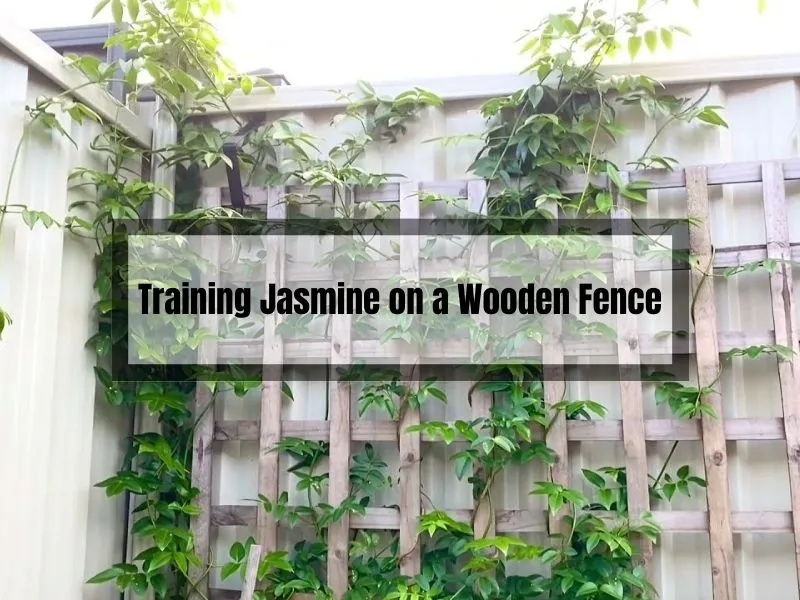Training Jasmine on a Wooden Fence: A Step-by-Step Guide
You’ve decided to add some greenery to your backyard, and you’ve chosen jasmine to do the job. Not only does jasmine smell amazing, but it also adds a touch of elegance to your garden.
However, you’re not quite sure how to train jasmine to climb on your wooden fence. No need to worry, we’ve got you covered. In this article, we’ll provide you with a step-by-step guide on how to train jasmine on a wooden fence.
Before we dive into the details, it’s important to choose the right jasmine variety for your fence. There are several types of jasmine, and each has its own unique characteristics. Some jasmine varieties are more suitable for climbing, while others are better suited for ground cover.
Once you’ve chosen the right variety, it’s time to prepare your wooden fence. This involves cleaning the fence and making sure it’s sturdy enough to support the weight of the jasmine.
Key Takeaways
- Choosing the right jasmine variety is crucial for training it to climb on a wooden fence.
- Preparing the wooden fence is an important step to ensure that the jasmine grows properly.
- Properly planting and training the jasmine will help it climb and cover the wooden fence.

How to Train Jasmine on a Wooden Fence
If you want to add some beauty to your wooden fence, training jasmine on it is a great way to do so.
Jasmine is a beautiful flowering plant that can add a touch of elegance to any wooden fence. Here are some steps to follow when training jasmine on a wooden fence:
- Choose the right type of jasmine: There are many different types of jasmine, but not all of them are suitable for growing on a fence. For example, the common jasmine (Jasminum officinale) is a climbing plant that can grow up to 10 feet tall, making it perfect for training on a fence. The Arabian jasmine (Jasminum sambac) is another great option, as it is a fast-growing plant that produces fragrant flowers.
- Prepare the fence: Before you start training jasmine on your fence, you need to make sure it is ready to support the plant. Install some support wires or trellis on the fence to provide a structure for the plant to climb.
- Plant the jasmine: Dig a hole near the base of the fence, and plant the jasmine at a distance of about 2 feet from the fence. Make sure to water the plant regularly to help it establish itself.
- Train the vines: Once the jasmine starts to grow, gently wrap the vines around the support wires or trellis. You can use twine or plant ties to hold the vines in place.
- Prune the vines: To encourage the jasmine to grow along the fence, you will need to prune the vines regularly. Cut back any unwanted growth, and trim the vines to the desired length.
- Provide support: As the jasmine grows, it will need additional support to keep it from falling off the fence. Check the support wires or trellis regularly, and make any necessary adjustments to keep the plant growing in the right direction.
Choosing the Right Jasmine Variety
Jasmine is a beautiful and fragrant plant that can add a touch of elegance and charm to any garden or outdoor space.
There are many different varieties of jasmine to choose from, each with its own unique characteristics and growing requirements. When selecting a jasmine variety to train on your wooden fence, consider the following factors:
Climate and Hardiness
Jasmine plants are native to tropical and subtropical regions, and as such, they require warm temperatures and ample sunlight to thrive.
Some varieties, such as Arabian jasmine, are more cold-tolerant and can withstand cooler temperatures, while others, such as the popular Star jasmine, require warmer climates to flourish. Be sure to choose a jasmine variety that is well-suited to your local climate and hardiness zone.
Growth Habits
Jasmine plants can grow in a variety of ways, including as shrubs, ground covers, and vines. When selecting a jasmine variety to train on your wooden fence, consider the growth habit of the plant and choose one that is well-suited to your needs.
For example, if you want a jasmine plant that will quickly cover your fence, choose a fast-growing variety such as Confederate jasmine. If you prefer a more compact plant that won’t require as much pruning, consider a shrub-like variety such as Winter jasmine.
Fragrance
One of the most appealing aspects of jasmine is its sweet and intoxicating fragrance. Different jasmine varieties have different levels of fragrance, so be sure to choose a variety that appeals to your senses.
Some of the most fragrant jasmine varieties include Arabian jasmine, Grand Duke of Tuscany jasmine, and Sampaguita jasmine.
Other Considerations
In addition to the factors listed above, there are other considerations to keep in mind when selecting a jasmine variety to train on your wooden fence. These include:
- Soil type and pH requirements
- Sunlight and shade preferences
- Watering and fertilizing needs
- Disease resistance and pest tolerance
By carefully considering these factors and choosing the right jasmine variety for your wooden fence, you can enjoy the beauty and fragrance of this lovely plant for years to come.
Preparing the Wooden Fence
Before you start training jasmine on your wooden fence, you need to make sure the fence is ready to support the plant. Here are the steps you should take to prepare the wooden fence:
1. Clean the Fence
The first step is to clean the fence. Remove any debris or dirt that may be on the fence. You can use a pressure washer or a garden hose to clean the fence. Make sure the fence is completely dry before moving on to the next step.
2. Install a Trellis or Support Wires
Jasmine needs support to grow properly, so you’ll need to install a trellis or support wires on the fence.
A trellis is a wooden or metal frame that you attach to the fence. Support wires are thin wires that you attach to the fence in a crisscross pattern. Make sure the trellis or support wires are securely attached to the fence.
3. Choose the Right Jasmine Plant
There are many types of jasmine plants, so make sure you choose the right one for your fence.
Confederate jasmine and star jasmine are two popular choices for growing on fences. They both have fragrant flowers and can be trained to grow on a fence.
4. Plant the Jasmine
Once you have the support in place and have chosen the right jasmine plant, it’s time to plant it. Dig a hole in front of the trellis or support wires and plant the jasmine. Make sure the soil is well-draining and the plant is at the same level as it was in the pot.
5. Water and Mulch
After planting the jasmine, water it thoroughly. Keep the soil moist but not waterlogged. Mulch around the base of the plant to help retain moisture and suppress weeds.
By following these steps, you’ll have a wooden fence that’s ready to support your jasmine plant. In the next section, we’ll go over how to train the jasmine to grow on the fence.
Planting the Jasmine
So, you’ve decided to add some beautiful jasmine to your wooden fence. Great choice! Here’s how to plant it:
- Choose a healthy plant: When choosing your jasmine plant, make sure it’s healthy and free from any diseases or pests. Look for plants with green leaves and no signs of wilting.
- Pick the right spot: Jasmine plants need plenty of sunlight to grow, so make sure you choose a spot on your fence that gets at least six hours of direct sunlight each day.
- Prepare the soil: Jasmine plants prefer well-draining soil, so mix some compost or other organic matter into the soil before planting. This will help improve drainage and provide your plant with the nutrients it needs.
- Dig a hole: Dig a hole in the soil that’s about twice as wide as the root ball of your jasmine plant. Make sure the hole is deep enough so that the top of the root ball sits level with the surface of the soil.
- Plant the jasmine: Carefully remove the jasmine plant from its container and loosen any tangled roots. Place the plant in the hole and backfill with soil, gently pressing the soil down around the base of the plant.
- Water thoroughly: After planting, give your jasmine plant a good watering to help settle the soil and remove any air pockets. Make sure the soil is moist but not waterlogged.
- Mulch: Adding a layer of mulch around the base of your jasmine plant can help retain moisture and suppress weeds. Just be sure not to pile the mulch up against the stem of the plant, as this can lead to rot.
Following these steps will help ensure that your jasmine plant gets off to a healthy start and thrives on your wooden fence. Happy planting!
Training the Jasmine to Climb
Now that you have decided to train your jasmine plant to climb your wooden fence, it’s time to get started. With proper care and attention, jasmine can be trained to grow on almost any type of wooden fence.
Here are some steps you can follow to train your jasmine to climb:
- Choose a healthy jasmine plant: Make sure you select a healthy jasmine plant that is at least one year old. It should have a strong stem and healthy leaves.
- Select a location: Choose a location that gets plenty of sunlight and has well-draining soil. The area should also be close to the wooden fence you want to train your jasmine on.
- Install a trellis: A trellis can be a great start for training your jasmine plant. Simply place this trellis next to your plant and gently attach the main trunk of the tree to it using a soft string or plant ties.
- Weave the vines through the trellis: Once your jasmine plant starts growing, weave the vines through the trellis holes. This will help the plant climb and provide support.
- Prune regularly: Regular pruning is essential for training your jasmine plant to climb. Remove any dead or damaged branches and trim back any excess growth.
- Fertilize: Fertilize your jasmine plant regularly to promote healthy growth. Use a balanced fertilizer that contains equal amounts of nitrogen, phosphorus, and potassium.
- Water regularly: Water your jasmine plant regularly, especially during the growing season. Make sure the soil remains moist but not waterlogged.
Remember, it may take some time for your jasmine plant to start climbing your wooden fence. Be patient and continue to provide the necessary care and attention. With time, you will have a beautiful, thriving jasmine plant climbing your wooden fence.
Maintaining the Jasmine
Once your jasmine plant has been trained to grow on your wooden fence, it’s important to maintain it properly to ensure it continues to thrive. Here are some tips to keep in mind:
Pruning
Regular pruning is essential for keeping your jasmine plant under control and promoting healthy growth. Prune the plant after it has finished flowering to encourage new growth for the following season. You can also prune the plant throughout the growing season to keep it from getting too unruly.
When pruning, be sure to use sharp, clean pruning shears to avoid damaging the plant. Cut back any dead or damaged branches, as well as any branches that are growing in the wrong direction. You can also trim back the tips of the branches to encourage bushier growth.
Watering
Jasmine plants require regular watering to stay healthy, especially during the hot summer months. Water the plant deeply once or twice a week, depending on the weather and soil conditions.
Be sure to water the plant at the base, rather than from above, to avoid getting water on the leaves and flowers.
Fertilizing
Fertilizing your jasmine plant can help promote healthy growth and vibrant blooms. Use a balanced, slow-release fertilizer in the spring, and again in midsummer.
Be sure to follow the instructions on the fertilizer package carefully, as over-fertilizing can damage the plant.
Pest Control
Jasmine plants are generally quite hardy and resistant to pests and diseases. However, they can occasionally fall victim to aphids, spider mites, and other common garden pests.
If you notice signs of pest infestation, such as distorted leaves or sticky residue on the plant, treat the plant with an insecticidal soap or neem oil spray.
Winter Care
Jasmine plants are generally hardy in warmer climates, but they may need some extra care during the winter months. If you live in an area with cold winters, consider wrapping the plant in burlap or other protective material to shield it from the cold. You can also mulch around the base of the plant to help insulate the roots.
By following these simple maintenance tips, you can ensure that your jasmine plant stays healthy and beautiful for years to come.
Can Jasmine Grow on Any Type of Wooden Fence?
Jasmine can grow on many different types of wooden fences, but some may be better suited than others. For example, a fence made of cedar or redwood will be more resistant to rot and decay, which can be important if you live in a wet or humid climate.
Additionally, a fence with wider slats or gaps may be easier for the jasmine to climb, as it will have more surface area to grab onto. However, with proper care and attention, jasmine can be trained to grow on almost any type of wooden fence.
What Other Plants Can Be Trained on a Wooden Fence?
While jasmine is a popular choice for training on wooden fences, there are many other plants that can thrive in this environment as well. Here are a few options:
- Clematis: This flowering vine comes in a variety of colors and can grow up to 20 feet long.
- Honeysuckle: Another fragrant option, honeysuckle can attract hummingbirds and butterflies to your yard.
- Passionflower: With its unique, intricate flowers, passionflower can add a touch of exotic flair to your fence.
- Ivy: A classic choice, ivy can create a lush, green backdrop for your garden.
Each of these plants has its own unique requirements and care instructions, so be sure to do your research before deciding which one to plant.
Different Techniques for Training Jasmine on a Wooden Fence
Once you’ve chosen the right jasmine variety and prepared the fence, it’s time to start training the jasmine. Here are a few different techniques you can use:
- Twining: Twine the jasmine stems around the support wires as they grow.
- Tying: Tie the jasmine stems to the support wires using garden twine or string.
- Weaving: Weave the jasmine stems in and out of the support wires to create a lattice effect.
FAQs
Can Jasmine Damage a Wooden Fence?
No, Jasmine is not known to damage a wooden fence. However, it is important to note that Jasmine plants can be quite vigorous and may grow rapidly, so it is important to keep them pruned and under control to prevent them from overwhelming the fence. Additionally, Jasmine plants can attract bees and other insects, so it is important to take precautions to prevent insect damage to the fence.
How Long Does It Take for Jasmine to Cover a Wooden Fence?
The amount of time it takes for Jasmine to cover a wooden fence will depend on a number of factors, including the type of Jasmine plant you are using, the climate in your area, and the amount of sunlight and water the plant receives. In general, however, you can expect Jasmine to grow at a rate of about 1-2 feet per year, so it may take several years for the plant to completely cover a fence. It is important to be patient and to provide your Jasmine plant with the proper care and attention to ensure that it grows strong and healthy.
Conclusion
So, there you have it folks! Training jasmine on a wooden fence may seem like a daunting task, but with a little bit of patience, persistence, and knowledge, you can turn your fence into a beautiful, fragrant masterpiece.
Remember, the key to success is selecting the right type of jasmine for your climate, providing adequate support for the vines, and regularly pruning and shaping the plant to encourage healthy growth.
Whether you’re looking to add a pop of color to your backyard or simply want to enjoy the sweet scent of jasmine on a warm summer evening, following these tips and tricks will help you achieve your gardening goals.
So, what are you waiting for? Grab your gardening gloves, head outside, and start training your jasmine today!
Related Posts:
- How to Propagate Star Jasmine from Cuttings: A Comprehensive Guide
- Easy Ways to Propagate Jasmine Without Rooting Hormone
- Jasmine Trachelospermum Problems: Recognizing and Solving Common Issues
- Master Guide: Make Your Potted Climbing Jasmine Flourish
- Is Star Jasmine Poisonous to Humans? What You Need to Know






